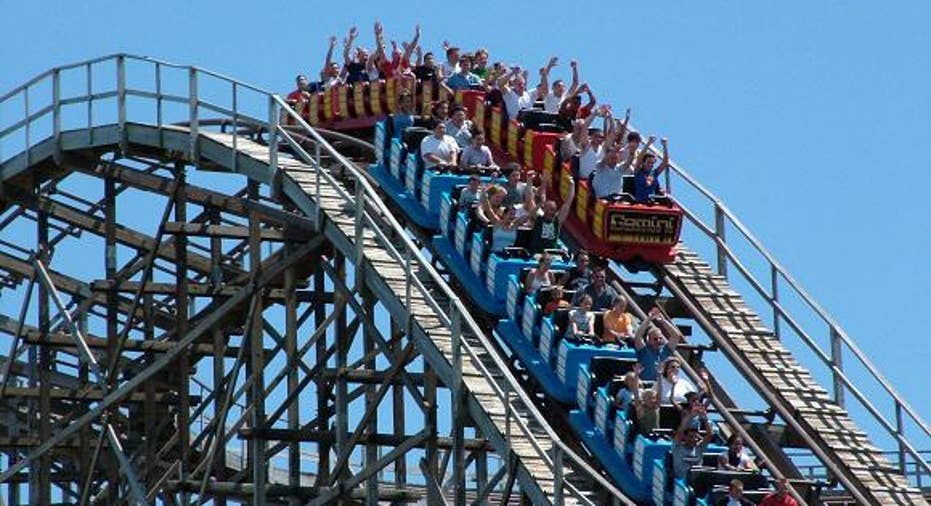How Risky Is Dynavax Technologies Stock?

Image source: Wikimedia Commons user Stratosphere.
Six swings of 20% or more over the last 12 months -- that's the roller-coaster ride that Dynavax Technologies shareholders have been on. For now, those shareholders are experiencing another upswing. Will the current positive momentum continue, or is Dynavax simply too risky to enjoy the ride?
Regulatory riskThe most obvious risk facing Dynavax is regulatory approval for hepatitis B vaccine Heplisav-B. Last week, the biotech announced that the Food and Drug Administration had accepted theBiologics License Application (BLA) for Heplisav-B with a decision due bySept. 15, 2016. For those who have followed Dynavax for several years, this might seem like deja vu.
It was only three years ago that the FDA shot down Dynavax's attempt to win approval for its hep-B vaccine. At that time, regulators expressed concern about Heplisav's safety profile. Dynavax was forced to go back to the drawing board.
What's the risk of history repeating itself? Fortunately, Dynavax is in much better shape this time around. Heplisav-B clearly beats the existing market leader, GlaxoSmithKline's Engerix-B, in terms of effectiveness: Dynavax's vaccine achieved peak seroprotection rates of 95.7% versus only 79.5% for Glaxo's vaccine. But effectiveness wasn't the issue three years ago and likely won't be now.
Dynavax's challenge is to convince the FDA that Heplisav-B is safe.The safety results from the latest study showed that 22 patients taking Heplisav-B experienced an adverse event of special interest (AESI), whereas 11 patients taking Engerix-B experienced AESIs. That might sound bad at first, but twice as many patients in the study were given Heplisav-B as were given Glaxo's vaccine, so the two vaccines broke even in that regard. Further, an independentpanel of experts from theMayo Clinic concluded that none of the AESIs reported were due to vaccination.
Over 10,000 patients have now participated in clinical trials of the vaccine, and Heplisav-B appears to have a similar safety profile to Engerix-B.Anything can happen behind closed doors when the FDA makes its decision, but I think Dynavax's odds appear pretty good this time.
Commercialization riskEven if Heplisav-B secures regulatory approval, there's still another hurdle to jump: Dynavax must launch the vaccine successfully.
The company will need a lot of money to bring Heplisav-B to market. As of the end of 2015, Dynavax had$196.1 millionin cash, cash equivalents, and marketable securities on hand. Considering that losses last year totaled nearly $107 million, more money must be raised to pull off a successful launch.
There probably won't be any problems raising additional cash. However, how Dynavax chooses to generate the additional money could present a risk for shareholders. Another public offering of stock could dilute existing shares, causing Dynavax's share price to drop.
Dynavax should have a good marketing message, assuming the FDA approves Heplisav-B. Not only does the vaccine seem more effective than GlaxoSmithKline's Engerix-B, but only two doses of Heplisav-B given one month apart are required for protection against hepatitis B. Engerix-B requires three doses over a six-month period.
To be successful, though, Dynavax has to meet sales expectations. Some think Heplisav-B could reach peak annual sales of $775 million. It's possible that Dynavax gains regulatory approval, effectively rolls out the hep-B vaccine, and achieves commercial success -- but still doesn't generate enough revenue to be viewed as a winner.
Beyond HeplisavWhile Dynavax's primary risks relate to Heplisav-B, the company does have other products in the pipeline. All of these drugs are in early-stage clinical studies, so each of them faces considerable risks.
SD-101 is a cancer immunotherapy in phase 1/2 testing.DV1179 is a toll-like receptor inhibitor in phase 1 that targets treatment of autoimmune and inflammatory diseases. Not only do these candidates face the normal clinical risks, but there's also the possibility that Dynavax won't be able to spare the cash to keep advancing the drugs, given the financial drain of a product launch.
That risk doesn't apply to the company's other product in clinical testing, though. Dynavax announced in January that its partner, AstraZeneca , would conduct phase 2 testing of asthma drugAZD1419. Dynavax originally planned to handle this study, though AstraZeneca had already agreed to fundit.
The AstraZeneca partnership could also help Dynavax address some of its financial needs. Their original deal provided for milestone payments when the phase 2 study is initiated.
Risk ratingSo what is Dynavax's overall risk level? I'd say on a 10-point scale, the biotech's risk rating is a six. That's actually not bad for a company with no products yet on the market.
My hunch is that the second time will prove the charm for Heplisav-B. I'm not so sure if Heplisav-B's sales will ultimately reach some estimates, but I do think the vaccine will be well received. While Dynavax shareholders have definitely experienced a roller-coaster ride, my view is that the risk of going off the tracks will diminish as time goes by.
The article How Risky Is Dynavax Technologies Stock? originally appeared on Fool.com.
Keith Speights has no position in any stocks mentioned. The Motley Fool has no position in any of the stocks mentioned. Try any of our Foolish newsletter services free for 30 days. We Fools may not all hold the same opinions, but we all believe that considering a diverse range of insights makes us better investors. The Motley Fool has a disclosure policy.
Copyright 1995 - 2016 The Motley Fool, LLC. All rights reserved. The Motley Fool has a disclosure policy.